Post by nowheregirl on Sept 28, 2007 9:24:13 GMT 1
In his life
John Lennon's drawings are a virtual lens on an extraordinary life
by Allen Clapp
Palo Alto Online Staff
www.paloaltoonline.com/news/show_story.php?id=5925
John Lennon would be 67 this October. And according to Yoko Ono, if John were still with us today, he would be "handsome, in a stately kind of way, and probably addicted to the computer," she said last week from a London hotel room.
"He would also be very, very angry with what's going on in the world right now. I can see him being very emotional and saying, 'We've got to do something about this.'"
This Dec. 8 will be the 27th anniversary of Lennon's death, but his message is still very much alive.
And while his song catalog - with the Beatles in the 1960s, and as a solo artist in the 1970s - is the stuff of legend, his visual art is a lesser-known quantity. Serious Lennon fans may know that Lennon was an art student in Liverpool while the Beatles were forming. And they may remember his first published experiments with art outside the realm of song, the books "In His Own Write" (1964) and "A Spaniard in the Works" (1965). Alongside the whimsical, stream-of-consciousness prose of those books were Lennon's surreal, playful line drawings.
It should be no surprise then, that Lennon continued drawing the rest of his life. As his musical output became less regular in his post-Beatles years, his pen became a virtual lens on his increasingly private life.
From Oct. 4-7, Palo Altans can get an up-close look for themselves when Ono presents "Come Together," an exhibition of Lennon's artwork, at Stanford Shopping Center. The traveling exhibit features the largest collection of his works ever assembled, including rare works from his "A Spaniard in the Works" period in the mid 1960s; his "Bag-One" erotic suite from 1970; the "Real Love" children's drawings he made for his son, Sean; and reproductions of song lyrics.
Even those not familiar with Lennon's visual art may be in for a treat.
"John's art is very real. He was a very real person - he grew up in a working-class town and his art was always meant to be accessible," Ono said.
Some of the messages are political. "Peace on Earth," a 1979 drawing he made while living in the Dakota apartment building in Manhattan, depicts a larger-than-life, somewhat bewildered Lennon standing on a deserted highway with his head above the clouds, a bright sun shining in the background. "Power to the People" (1978) features a Lennon-esque Statue of Liberty whose hand is clenched in a fist instead of holding a torch. And his "Imagine All the People" from the mid-'70s is quintessential John, sitting on top of the world, wondering why we can't live life in peace.
"He made and liked art that said things - not just pretty wallpaper. He had a word for art like that: crap," Ono said.
The late-'60s drawings in particular read like a photo album in line drawings: "I do," "The Honeymoon," "Bag One" and "Bed-in for Peace" document Lennon's and Ono's nuptials, and create the perfect visual accompaniment to his song "The Ballad of John and Yoko." Some of his erotic drawings from the era were confiscated by Scotland Yard detectives during a show in 1970 for being "offensive to public good taste."
But the overwhelming majority of the works at the Stanford Shopping Center exhibit are introspective, private, even mundane moments from an extraordinary life.
"Manhattan Diary" (1978) shows John sitting on a bed sketching, a napping cat curled up at his feet, and a piano lurking in the background. "Baby Grand" (1974) is John at the piano, composing. "On the Telephone with Family," depicts John reclining on a couch while Yoko is sitting up at the other end, talking on the phone. A young Sean Lennon is on the floor, reaching up to his father.
"John did use his art as therapy to some extent. He was very autobiographical," Ono said.
Toward the end of his life, he created a series of drawings for Sean that combined his sense of humor with lessons about the natural world.
"A Cat Napping," "A Worm Turning" and "A Frog Pondering" all feature some visual pun. There is a childlike wonder in the series that brings to mind some of his surrealist imagery in songs such as "I Am the Walrus," "For the Benefit of Mr. Kite," and "Lucy in the Sky with Diamonds."
Ono says there is a direct connection. "John was always creating. He was a multimedia artist, and art was always flowing out of him."
His connection with the natural world is never so clear as when he drew himself sitting in an armchair, deep in thought, with a cat next to him in "Why Not?" (1978).
"John was a cat-man," Ono said. "We had three cats. He always had trouble sleeping, and he would get up in the middle of the night and go into the kitchen. The cats would all follow him in there. He'd stay up for a few hours, writing, sketching ... he loved hanging out with the cats.
"After he died, anytime anyone went into the kitchen at night, the cats would follow them in there, looking for John."
There has been some controversy about the way some of Lennon's art is being presented. For the exhibit, some of Lennon's drawings - originally pen-and-ink, black-and-white renderings - have been colorized; this is a decision and a process Yoko undertook herself. Originally, she had trouble interesting art galleries in displaying Lennon's work. "People in the art world would tell me 'We won't put it in the window unless it's color,' so I figured I should do it myself," Ono said.
Ono was a respected artist before she met Lennon, and her work in the Fluxus movement in the 1960s was as much about smashing boundaries as it was about having fun. It was at an Ono exhibit in 1966 that Lennon became fascinated with her. "We understood one another, almost instantly," she said.
"I spent a year and a day adding color to John's drawings. Some people have said, 'How dare you do this,' but I think it helps bring his drawings into a modern context. It's been done in a delicate way. As artists and a couple, we always had to be sensitive to each other," Ono said.
Proceeds of the sale of prints will benefit the Stanford Ronald McDonald House, which provides a home away from home for families of children with life-threatening diseases.
It may be as close as Palo Alto has come to hosting the Beatles since the fabs stayed overnight at the Cabana on El Camino Real in 1965.
John Lennon's drawings are a virtual lens on an extraordinary life
by Allen Clapp
Palo Alto Online Staff
www.paloaltoonline.com/news/show_story.php?id=5925
John Lennon would be 67 this October. And according to Yoko Ono, if John were still with us today, he would be "handsome, in a stately kind of way, and probably addicted to the computer," she said last week from a London hotel room.
"He would also be very, very angry with what's going on in the world right now. I can see him being very emotional and saying, 'We've got to do something about this.'"
This Dec. 8 will be the 27th anniversary of Lennon's death, but his message is still very much alive.
And while his song catalog - with the Beatles in the 1960s, and as a solo artist in the 1970s - is the stuff of legend, his visual art is a lesser-known quantity. Serious Lennon fans may know that Lennon was an art student in Liverpool while the Beatles were forming. And they may remember his first published experiments with art outside the realm of song, the books "In His Own Write" (1964) and "A Spaniard in the Works" (1965). Alongside the whimsical, stream-of-consciousness prose of those books were Lennon's surreal, playful line drawings.
It should be no surprise then, that Lennon continued drawing the rest of his life. As his musical output became less regular in his post-Beatles years, his pen became a virtual lens on his increasingly private life.
From Oct. 4-7, Palo Altans can get an up-close look for themselves when Ono presents "Come Together," an exhibition of Lennon's artwork, at Stanford Shopping Center. The traveling exhibit features the largest collection of his works ever assembled, including rare works from his "A Spaniard in the Works" period in the mid 1960s; his "Bag-One" erotic suite from 1970; the "Real Love" children's drawings he made for his son, Sean; and reproductions of song lyrics.
Even those not familiar with Lennon's visual art may be in for a treat.
"John's art is very real. He was a very real person - he grew up in a working-class town and his art was always meant to be accessible," Ono said.
Some of the messages are political. "Peace on Earth," a 1979 drawing he made while living in the Dakota apartment building in Manhattan, depicts a larger-than-life, somewhat bewildered Lennon standing on a deserted highway with his head above the clouds, a bright sun shining in the background. "Power to the People" (1978) features a Lennon-esque Statue of Liberty whose hand is clenched in a fist instead of holding a torch. And his "Imagine All the People" from the mid-'70s is quintessential John, sitting on top of the world, wondering why we can't live life in peace.
"He made and liked art that said things - not just pretty wallpaper. He had a word for art like that: crap," Ono said.
The late-'60s drawings in particular read like a photo album in line drawings: "I do," "The Honeymoon," "Bag One" and "Bed-in for Peace" document Lennon's and Ono's nuptials, and create the perfect visual accompaniment to his song "The Ballad of John and Yoko." Some of his erotic drawings from the era were confiscated by Scotland Yard detectives during a show in 1970 for being "offensive to public good taste."
But the overwhelming majority of the works at the Stanford Shopping Center exhibit are introspective, private, even mundane moments from an extraordinary life.
"Manhattan Diary" (1978) shows John sitting on a bed sketching, a napping cat curled up at his feet, and a piano lurking in the background. "Baby Grand" (1974) is John at the piano, composing. "On the Telephone with Family," depicts John reclining on a couch while Yoko is sitting up at the other end, talking on the phone. A young Sean Lennon is on the floor, reaching up to his father.
"John did use his art as therapy to some extent. He was very autobiographical," Ono said.
Toward the end of his life, he created a series of drawings for Sean that combined his sense of humor with lessons about the natural world.
"A Cat Napping," "A Worm Turning" and "A Frog Pondering" all feature some visual pun. There is a childlike wonder in the series that brings to mind some of his surrealist imagery in songs such as "I Am the Walrus," "For the Benefit of Mr. Kite," and "Lucy in the Sky with Diamonds."
Ono says there is a direct connection. "John was always creating. He was a multimedia artist, and art was always flowing out of him."
His connection with the natural world is never so clear as when he drew himself sitting in an armchair, deep in thought, with a cat next to him in "Why Not?" (1978).
"John was a cat-man," Ono said. "We had three cats. He always had trouble sleeping, and he would get up in the middle of the night and go into the kitchen. The cats would all follow him in there. He'd stay up for a few hours, writing, sketching ... he loved hanging out with the cats.
"After he died, anytime anyone went into the kitchen at night, the cats would follow them in there, looking for John."
There has been some controversy about the way some of Lennon's art is being presented. For the exhibit, some of Lennon's drawings - originally pen-and-ink, black-and-white renderings - have been colorized; this is a decision and a process Yoko undertook herself. Originally, she had trouble interesting art galleries in displaying Lennon's work. "People in the art world would tell me 'We won't put it in the window unless it's color,' so I figured I should do it myself," Ono said.
Ono was a respected artist before she met Lennon, and her work in the Fluxus movement in the 1960s was as much about smashing boundaries as it was about having fun. It was at an Ono exhibit in 1966 that Lennon became fascinated with her. "We understood one another, almost instantly," she said.
"I spent a year and a day adding color to John's drawings. Some people have said, 'How dare you do this,' but I think it helps bring his drawings into a modern context. It's been done in a delicate way. As artists and a couple, we always had to be sensitive to each other," Ono said.
Proceeds of the sale of prints will benefit the Stanford Ronald McDonald House, which provides a home away from home for families of children with life-threatening diseases.
It may be as close as Palo Alto has come to hosting the Beatles since the fabs stayed overnight at the Cabana on El Camino Real in 1965.






 awww poor cats
awww poor cats  and I miss John xx
and I miss John xx

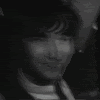



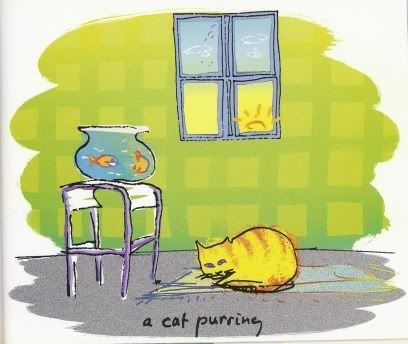
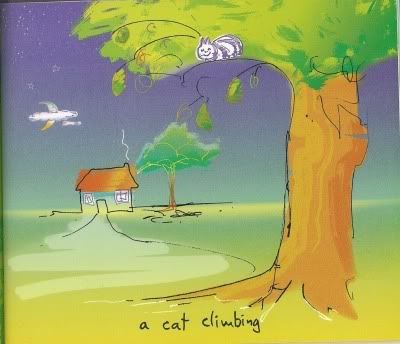

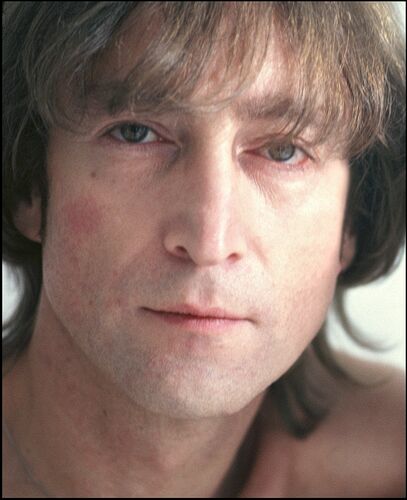

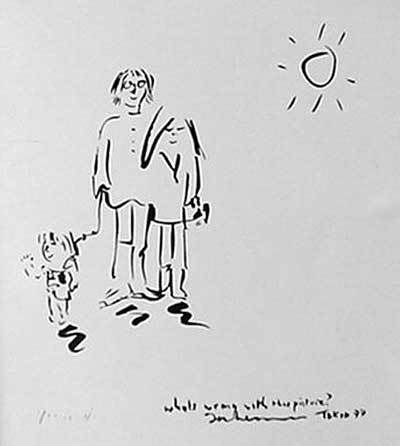

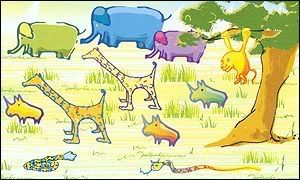


 Thank you!!
Thank you!!